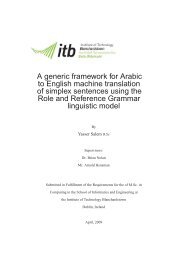On the occurrence and consequences of inaccurate ... - Acsu Buffalo
On the occurrence and consequences of inaccurate ... - Acsu Buffalo
On the occurrence and consequences of inaccurate ... - Acsu Buffalo
Create successful ePaper yourself
Turn your PDF publications into a flip-book with our unique Google optimized e-Paper software.
E.R. Odders-White / Journal <strong>of</strong> Financial Markets 3 (2000) 259}286 275<br />
are $18 5/8 <strong>and</strong> $18 3/4, respectively, <strong>and</strong> <strong>the</strong> ask increases to $18 7/8. Transactions<br />
are indicated with two letters. The "rst letter represents <strong>the</strong> true classi"cation<br />
(B"buy <strong>and</strong> S"sell). The second letter represents <strong>the</strong> Lee <strong>and</strong> Ready<br />
classi"cation. The problematic transaction (which is labeled with a star in <strong>the</strong><br />
diagram) is <strong>the</strong> buyer-initiated trade occurring immediately after <strong>the</strong> increase in<br />
<strong>the</strong> ask price. Since it is a midpoint transaction, it is classi"ed using <strong>the</strong> tick<br />
method <strong>and</strong> is labeled as seller-initiated because it is a zero-downtick.<br />
This systematic misclassi"cation stems from <strong>the</strong> guidelines regarding specialist<br />
behavior at <strong>the</strong> NYSE. The specialist is required to keep a fair <strong>and</strong> orderly<br />
market, which includes posting reasonable depth. He can do so in two ways: by<br />
simply re#ecting <strong>the</strong> limit order book (i.e. posting bid <strong>and</strong> ask prices equal to <strong>the</strong><br />
best bid <strong>and</strong> ask on <strong>the</strong> limit order book <strong>and</strong> posting depths equal to <strong>the</strong> number<br />
<strong>of</strong> shares on <strong>the</strong> book at those prices) or by posting additional shares himself.<br />
Suppose <strong>the</strong> specialist chooses to re#ect only <strong>the</strong> shares on <strong>the</strong> limit order book<br />
but feels that <strong>the</strong> shares at <strong>the</strong> best prices on <strong>the</strong> book do not provide su$cient<br />
depth. In this case, he may &move up' <strong>the</strong> limit order book to post a price at<br />
which <strong>the</strong>re are more shares on <strong>the</strong> book. In o<strong>the</strong>r words, he may choose to<br />
widen <strong>the</strong> spread by increasing <strong>the</strong> ask (<strong>and</strong>/or decreasing <strong>the</strong> bid) in order to<br />
post more depth. The result is one or more hidden limit orders on <strong>the</strong> side <strong>of</strong> <strong>the</strong><br />
market in which <strong>the</strong> quote was moved. When <strong>the</strong>se limit orders are hit, <strong>the</strong><br />
transaction occurs at <strong>the</strong> spread midpoint. Transactions taking place under<br />
<strong>the</strong>se circumstances are much more likely to occur within 30 s <strong>of</strong> a quote change<br />
(37.61%) than transactions in <strong>the</strong> full sample (15.86%).<br />
Roughly, 10% <strong>of</strong> <strong>the</strong> misclassi"ed transactions in my sample occur in this<br />
situation. Changes in <strong>the</strong> NYSE guidelines prohibiting specialists from hiding<br />
limit orders in this manner went into e!ect in 1996 <strong>and</strong> should improve <strong>the</strong><br />
overall accuracy <strong>of</strong> <strong>the</strong> algorithm.<br />
Also recall that <strong>the</strong> Lee <strong>and</strong> Ready algorithm employs <strong>the</strong> tick method for<br />
midpoint transactions <strong>and</strong> that this method classi"es zero-tick trades (transactions<br />
for which <strong>the</strong>re is no price change) by referring back to <strong>the</strong> last price<br />
change. Consequently, any midpoint transactions immediately following <strong>the</strong><br />
trade in question (at <strong>the</strong> same price) will also be misclassi"ed.<br />
In fact, zero-tick trades are problematic in general because <strong>the</strong> prior trade is<br />
<strong>of</strong>ten an inappropriate benchmark. For example, if <strong>the</strong> prior trade took place<br />
long ago, it is &stale' <strong>and</strong> does not re#ect current market information. <strong>On</strong> <strong>the</strong><br />
o<strong>the</strong>r h<strong>and</strong>, if trading is very active, situations like that in Fig. 4 may occur, in<br />
which two or more transactions pick o! hidden limit orders at <strong>the</strong> midpoint.<br />
The results in Panel F <strong>of</strong> Table 4 verify that zero-tick midpoint trades are<br />
misclassi"ed much more frequently than o<strong>the</strong>r midpoint trades (40% vs. 23%).<br />
In addition, <strong>the</strong>se transactions account for 89% <strong>of</strong> <strong>the</strong> misclassi"cation occurring<br />
at <strong>the</strong> spread midpoint. Fig. 4 is only one example <strong>of</strong> a trading pattern that<br />
induces misclassi"cation. There are o<strong>the</strong>r such patterns, each accounting for<br />
a (sometimes small) fraction <strong>of</strong> <strong>the</strong> total misclassi"cation.
















